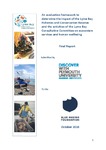An evaluation framework to determine the impact of the Lyme Bay Fisheries and Conservation Reserve and the activities of the Lyme Bay Consultative Committee on ecosystem services and human wellbeing.

Date
2016Author
Subject
Metadata
Show full item recordAbstract
This research evaluates the social and economic impact of the management measures that form the Lyme Bay Reserve and the partnership activities of the Lyme Bay Consultative Committee (LBCC) on Lyme Bay resource users. For the purpose of this evaluation it is the combination of the 2008 Statutory Instrument (SI) closure and the more recently designated Site of Community Interest (SCI) that form the boundary of the Lyme Bay Fisheries and Conservation Reserve, termed as the Lyme Bay Reserve.
Data is analysed between 2005 and 2015. The results show that the habitats and species of Lyme Bay interact to support the delivery of several ecosystem processes (e.g. primary and secondary production, formation of species habitat) and the realisation of ecosystem services (e.g. fish for food). Overall it is clear that the closure of the area to mobile fishing gear has benefitted static gear fishermen by separating spatial conflict between gear types. The closure has enabled reef habitats to recover which in turn has supported increased catches of some reef associated species e.g. scallops. Further management and support measures agreed through the LBCC have clearly been successful in improving the well-being for those fishermen directly involved in the project.
This research represents collaboration between Plymouth University, Exeter University, The Blue Marine Foundation and CEFAS. Input into the evaluation was provided by the Devon and Severn Inshore Fisheries and Conservation Authority (IFCA), the Southern IFCA, local fishermen and fishery representatives.
Collections
Parent title
Author URL
Recommended, similar items
The following license files are associated with this item:

